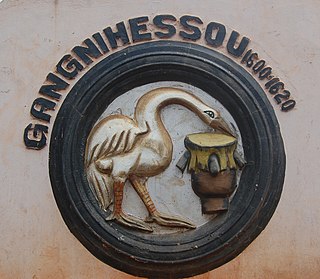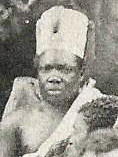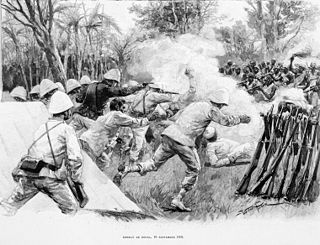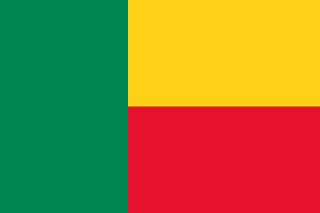
The Kingdom of Dahomey was a West African kingdom located within present-day Benin that existed from approximately 1600 until 1904. It developed on the Abomey Plateau amongst the Fon people in the early 17th century and became a regional power in the 18th century by expanding south to conquer key cities like Whydah belonging to the Kingdom of Whydah on the Atlantic coast which granted it unhindered access to the tricontinental Atlantic Slave Trade.

Do-Aklin or Gangnihessou or Dogbari is claimed as the founder of the Fon Kingdom of Dahomey in present-day Benin and the first person in the royal lineage of the Kings of Dahomey. In many versions he is considered the first king of Dahomey even though the kingdom was founded after his death. Very little is known about Do-Aklin and most of it is connected to folklore, but it is generally claimed that he settled a large group of Aja people from Allada on the Abomey plateau amongst the local inhabitants in c. 1620. His son Dakodonu would eventually build a palace on the plateau and began forming the Kingdom of Dahomey.

Dakodonou, Dakodonu, Dako Donu or Dako Danzo was an early king of the Kingdom of Dahomey, in present-day Benin, ruling from around 1620 until 1645. Oral tradition recounts that Dakodonu was the son of Do-Aklin, the founder of the royal dynasty of Dahomey, and the father to Houegbadja, often considered the founder of the Kingdom of Dahomey. In addition, it is said that Dakodonu killed a local chieftain and founded the capital city upon the site. However, some recent historical analysis contends that Dakodonu was added into the royal line in the 18th century to legitimize the ruling dynasty over the indigenous inhabitants of the Abomey plateau.

Houegbadja or Wegbaja or Aho was a King in the Kingdom of Dahomey, in present-day Benin, from around 1645 until 1685. Houegbadja followed his father Dakodonou to the throne and formed much of the administration and religious practices for the Kingdom of Dahomey. Because of this he is often credited as the First King of Dahomey.

Agaja was a king of the Kingdom of Dahomey, in present-day Benin, who ruled from 1718 until 1740. He came to the throne after his brother King Akaba. During his reign, Dahomey expanded significantly and took control of key trade routes for the Atlantic slave trade by conquering Allada (1724) and Whydah (1727). Wars with the powerful Oyo Empire to the east of Dahomey resulted in Agaja accepting tributary status to that empire and providing yearly gifts. After this, Agaja attempted to control the new territory of the kingdom of Dahomey through militarily suppressing revolts and creating administrative and ceremonial systems. Agaja died in 1740 after another war with the Oyo Empire and his son Tegbessou became the new king. Agaja is credited with creating many of the key government structures of Dahomey, including the Yovogan and the Mehu.

Tegbesu or Bossa Ahadee was a king of the Kingdom of Dahomey, in present-day Benin, from 1740 until 1774. While not the oldest son of King Agaja (1718-1740), he became king after Agaja's death following a succession struggle with a brother.

Kpengla was a King of the Kingdom of Dahomey, in present-day Benin, from 1774 until 1789. Kpengla followed his father Tegbessou to the throne and much of his administration was defined by the increasing Atlantic slave trade and regional rivalry over the profits from this trade. His attempts to control the slave trade generally failed, and when he died of smallpox in 1789, his son Agonglo came to the throne and ended many of his policies.

Agonglo was a King of the Kingdom of Dahomey, in present-day Benin, from 1789 until 1797. Agonglo took over from his father King Kpengla in 1789 and inherited many of the economic problems that developed during Kpengla's reign. Because of the poor economy, Agonglo was often constrained by domestic opposition. As a response, he reformed many of the economic policies and did military expeditions to try to increase the supply for the Atlantic slave trade. Many of these efforts were unsuccessful and European traders became less active in the ports of the kingdom. As a final effort, Agonglo accepted two Portuguese Catholic missionaries which resulted in a large outcry in royal circles and resulted in his assassination on May 1, 1797. Adandozan, his second oldest son, was named the new king.

Ghezo, also spelled Gezo, was King of Dahomey from 1818 until 1858. Ghezo replaced his brother Adandozan as king through a coup with the assistance of the Brazilian slave trader Francisco Félix de Sousa. He ruled over the kingdom during a tumultuous period, punctuated by the British blockade of the ports of Dahomey in order to stop the Atlantic slave trade.

Gbehanzin also known as Béhanzin is considered the eleventh King of Dahomey, modern-day Republic of Benin. Upon taking the throne, he changed his name from Kondo.

Agoli-agbo is considered to have been the twelfth and final King of Dahomey. He was in power from 1894 to 1900.

Agbome or Abomey is the capital of the Zou Department of Benin. The commune of Abomey covers an area of 142 square kilometres and, as of 2012, had a population of 90,195 people.

The Annual Customs of Dahomey were the main yearly celebration in the Kingdom of Dahomey, held at the capital, Abomey. These ceremonies were largely started under King Agaja around 1730 and involved significant collection and distribution of gifts and tribute, religious ceremonies involving human sacrifice, military parades, and discussions by dignitaries about the future for the kingdom.

The Dahomey Amazons were a Fon all-female military regiment of the Kingdom of Dahomey that existed from the 17th century until the late 19th century. They were the only female army in modern history. They were named Amazons by Western Europeans who encountered them, due to the story of the female warriors of Amazons in Greek mythology.

The Second Franco-Dahomean War, which raged from 1892 to 1894, was a major conflict between France, led by General Alfred-Amédée Dodds, and Dahomey under King Béhanzin. The French emerged triumphant and incorporated Dahomey into their growing colonial territory of French West Africa.

The following outline is provided as an overview of and topical guide to Benin:

The Royal Palaces of Abomey are 12 palaces spread over an area of 40 hectares at the heart of the Abomey town in Benin, formerly the capital of the West African Kingdom of Dahomey. The Kingdom was founded in 1625 by the Fon people who developed it into a powerful military and commercial empire, which dominated trade with European slave traders on the Slave Coast until the late 19th century, to whom they sold their prisoners of war. At its peak the palaces could accommodate up to 8000 people. The King's palace included a two-story building known as the "cowrie house" or akuehue. Under the twelve kings who succeeded from 1625 to 1900, the kingdom established itself as one of the most powerful of the western coast of Africa.
The History of the Kingdom of Dahomey spans 400 years from around 1600 until 1904 with the rise of the Kingdom of Dahomey as a major power on the Atlantic coast of modern-day Benin until French conquest. The kingdom became a major regional power in the 1720s when it conquered the coastal kingdoms of Allada and Whydah. With control over these key coastal cities, Dahomey became a major center in the Atlantic Slave Trade until 1852 when the British imposed a naval blockade to stop the trade. War with the French began in 1892 and the French took over the Kingdom of Dahomey in 1894. The throne was vacated by the French in 1900, but the royal families and key administrative positions of the administration continued to have a large impact in the politics of the French administration and the post-independence Republic of Dahomey, renamed Benin in 1975. Historiography of the kingdom has had a significant impact on work far beyond African history and the history of the kingdom forms the backdrop for a number of novels and plays.
Hangbe was a woman who served as the regent of the Kingdom of Dahomey for a brief period before Agaja came to power in 1718. According to oral tradition, she became regent upon the sudden death of King Akaba because his oldest son, Agbo Sassa, was not yet of age. The duration of her regency is unclear. She supported Agbo Sassa in a succession struggle against Agaja, who ultimately became king. Hangbe's legacy lives on in oral tradition, but little is known about her rule because it was largely erased from official history. It is possible that her gender and role as a woman in power contributed to her rule being erased from official history.
Yaya Migansi or Houekode was a princess of Dahomey, a kingdom in present-day Benin. Her father was Glele, who was the 10th king of Dahomey from 1858 to 1889. Her mother was Miagbe, also known as Hoonon Magnitin who gave birth to three sets of twins with Glele; Migansi was the first-born of the eldest pair of twins. Her name was Houekode, and the epithet "Yaya", an affectionate term meaning "old woman" is thought to refer to her mother. As her father was the future king, she and her sister were married to the two leading ministers of the kingdom: the name "Migansi" means wife or dependant of the "Migan" or prime minister.

















